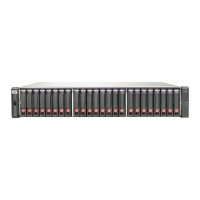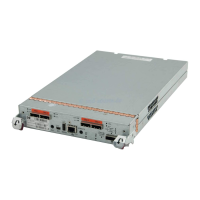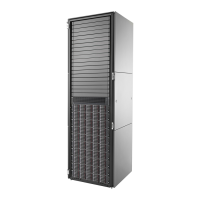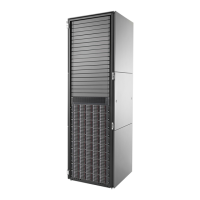HP StorageWorks P2000 G3 MSA System SMU Reference Guide 109
1. Synchronize the secondary volume to a replication snapshot, preferably a replication sync point. Any
data written to the primary volume since the last-completed replication will not be available.
2. After synchronization, set the secondary volume to be the new primary volume.
3. Map the new primary volume to hosts, as was the original primary volume.
Figure 6 Example of primary-volume failure
If the original primary volume becomes accessible, you can set it to be the primary volume again.
1. Take a snapshot of the original primary volume. This preserves the volume's current data state for later
comparison with the new primary volume.
2. Set the original primary volume to be a secondary volume.
3. Replicate any data written to the new primary volume to the original primary volume (now a secondary
volume). This can be done as one or more replications. On the final replication, halt host access to the
primary volume to ensure that all data has been transferred to the secondary volume.
4. Set the secondary volume (the original primary volume) to be the new primary volume.
5. You can now mount the snapshot taken in step 1 and compare it with the new primary volume to
identify any data discrepancies and try to recover any data from the snapshot that would otherwise be
lost. For example, you could use host file-system tools to find any files modified since a certain time, or
for a database you could export any differing records from the snapshot and re-enter them into the
current database.
Remote replication licensing
The Remote Replication and Snapshot features are separately licensed. Remote replication can operate
without Snapshot being enabled; however, to get the most out of remote replication, it is recommended to
enable both features. Normally, replication snapshots are not accessible to hosts. However, if Snapshot is
enabled, a replication snapshot can be exported for use as a standard snapshot.
Related topics
• Installing a license on page 41
• Adding (page 54) or deleting (page 54) a remote system
• Checking links to a remote system on page 87
• Using the Replication Setup Wizard on page 110
• Replicating a volume (page 111) or a snapshot (page 113 )
• Detaching (page 114) and reattaching (page 116) a secondary volume
• Stopping (page 115) and restarting (page 116 ) a v d i s k
